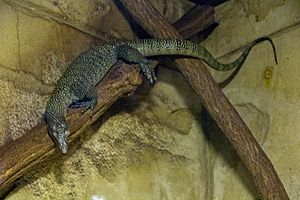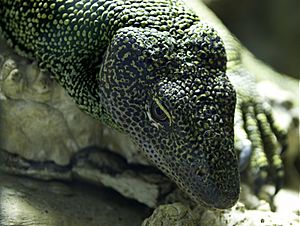Mangrove monitor facts for kids
The mangrove monitor (Varanus indicus) is a type of monitor lizard. It is also known as the mangrove goanna or Western Pacific monitor lizard. These lizards live in a wide area, from northern Australia and New Guinea to the Maluku Islands and Solomon Islands. They can grow to be about 3.5 to 4 feet long. Some populations once thought to be V. indicus are now seen as different species.
Quick facts for kids Mangrove monitor |
|
|---|---|
 |
|
| Conservation status | |
| Scientific classification | |
| Genus: |
Varanus
|
| Species: |
indicus
|
Contents
What They Are Called
In the Kalam language of Papua New Guinea, this lizard is known as wbl yb.
How They Got Their Name
The mangrove monitor was first described by a French scientist named François Marie Daudin in 1802. He first called it Tupinambis indicus. This name was used for 100 years before it was changed to Varanus.
The name Varanus comes from the Arabic word waral. This word means "monitor" in English. The second part of its name, indicus, is Latin for India. However, in this case, it refers to Indonesia or the Malay Archipelago. This is where the animal was first found and described.
Scientists now think that V. indicus might actually be a group of at least four different species. These include Varanus indicus, Varanus doreanus, Varanus spinulosus, and Varanus jobiensis. More research is being done to find out if there are even more species. This is not surprising, as this lizard has had over 25 different scientific names since it was first discovered.
Where They Live and Their Home
The mangrove monitor lives across northern Australia, New Guinea, and the Solomon Islands. It also lives on the Marshall Islands, the Caroline Islands, and the Mariana Islands. They prefer wet forests near coastal rivers, mangrove swamps, and lakes. They are also found on several Maluku Islands in Indonesia.
Because they live across thousands of miles and hundreds of islands, their size, patterns, and scales can look very different. These monitors have also been brought to Japan since the 1940s. Some scientists believe that ancient Polynesians helped spread these lizards to smaller Pacific islands. They might have done this to have a source of meat. However, other scientists disagree. They think the lizards would compete with humans for food and would not provide much meat.
Body and Features
The mangrove monitor's body is dark green or black. It has golden-yellow spots. The top of its head is light-colored, and its belly is a solid, cream color without dark marks. It has a dark purple tongue and teeth that are like saws.
These monitors do not usually grow longer than 1.3 meters (about 4.3 feet). Australian scientists say that monitors in Australia are usually about 100 cm (3.3 feet) long. Their tail is almost twice as long as their body. It is flat on the sides, which helps them swim. Like the rest of their body, the tail is covered with small, oval, bumpy scales.
This monitor can open its mouth very wide to eat large prey. It does this by spreading its jaw bones. This looks a bit like how snakes eat, but the monitor's jaw stays stiff. The mangrove monitor also has a special organ called a Jacobson's organ. It uses this to find prey by sticking its tongue out to pick up smells. Then it touches its tongue to the organ when it pulls it back in.
The mangrove monitor is one of only two types of monitor lizards that have special glands in their nose. These glands help them get rid of salt. This means they can live in saltwater areas and eat animals that live in the ocean. Having this gland likely helped them travel to new islands and spread across the Pacific Ocean.
What They Eat
The mangrove monitor is a carnivore, meaning it eats meat. It eats many different things, depending on what it can find. This includes eggs from reptiles and birds, snails, rodents, insects, crabs, smaller lizards, fish, and dead animals. Mangrove monitors are the only monitors that can catch fish in deep water. In some places, they are even known to eat young crocodiles.
On the Southern Mariana Islands, mangrove monitors changed what they ate. When their usual prey, like shrews, became scarce, they started eating insects and looking for food in human garbage. This happened after the brown tree snake was introduced, which caused shrew numbers to drop.
Reproduction and Life Cycle
It is hard to tell male and female mangrove monitors apart just by looking at them. However, on Guam, adult males have been found to be three times heavier than adult females. Males will fight each other to mate with females.
Female mangrove monitors lay between two and 12 eggs. The eggs are oval-shaped, white, and measure about 3.5 to 5 cm long. The eggs hatch in about seven to eight months.
The first time this species was successfully bred in a zoo was in 1993 at the Philadelphia Zoo. There was also a report from a zoo in the Netherlands where a female laid eggs that hatched, even though she had not been in contact with a male.
Contact with Humans
Humans have brought the mangrove monitor to several Pacific Islands since the 1930s. They were introduced to the Marshall Islands by the Japanese before World War II to help control rats. The lizards did very well, but then they started raiding local chicken coops. When American troops arrived, the locals asked for help to get rid of the monitors. The US introduced the marine toad, which was poisonous to the lizards. As the monitor population went down, the rat population went up again.
People in many places hunt the mangrove monitor for its skin. The skin is used to make leather, especially for drum heads. Even though not many are traded internationally, they are still one of the most hunted monitor lizards. In 1980, over 13,000 monitors were reported as being traded. In many remote areas, they are eaten as a traditional food. They are also killed because they are known to eat farm animals. Some people on Guam eat the monitors as a traditional food, and there is even a business that sells them for food.
On Cocos Island (Guam), there are efforts to reduce the mangrove monitor population. This is because they are believed to eat the endangered Guam Rail. However, many local people do not see the monitor as a harmful species. Some activists are against the idea of reducing the monitor population there.
Mangrove monitors are often kept in zoos and by private collectors. They are active and alert animals. If they are tamed properly, they can be handled. However, most will poop on their handlers if they feel stressed. With good care, they can live up to 20 years in captivity.





